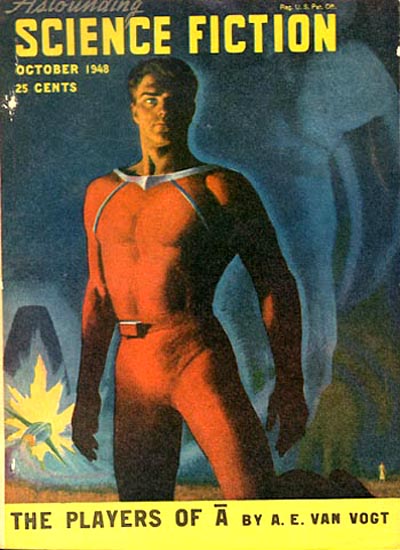Retro Fandom Friday – Astounding Sure Is Something…
Friday , 20, April 2018 Uncategorized 3 CommentsAfter a great story by Arthur C. Clarke, I was all ready for the September 49 issue of Astounding to start getting good… Only to find that was the last story.
Okay, that’s not really fair, because maybe L. Sprague DeCamp’s The Queen of Zamba was fantastic, but it was the 4th and final installment of a serialized novel, which took up a good chunk of the issue.
 Other features of the issue included a rather dry article on Cybernetics by E.L. Locke and something called “Progress Report”, by John H. Pomeroy, which was a lengthy jargon and BS-filled fake scientific report expanding on Astounding’s (particularly Asimov’s) prolonged trolling about Thiotimoline. I’m in no place to comment on this most literal approach to science fiction, so I’ll suffice to say that after a page or two I just skipped the rest.
Other features of the issue included a rather dry article on Cybernetics by E.L. Locke and something called “Progress Report”, by John H. Pomeroy, which was a lengthy jargon and BS-filled fake scientific report expanding on Astounding’s (particularly Asimov’s) prolonged trolling about Thiotimoline. I’m in no place to comment on this most literal approach to science fiction, so I’ll suffice to say that after a page or two I just skipped the rest.
The reviews of upcoming and current releases were so dry that even the books they praised sounded dull. Consider, though, the frame the reviewer is writing from that he needs to open with “Critics of science fiction insist that it can have no place as literature because it ignores basic human values; because its characters exist only to carry out some ingenious plot twist or put some novel gadget through its paces. However just this complaint may be when applied to the field as a whole, it is flatly refuted in the twelves stories by Lester del Rey which Prime Press has published under the title “…And Some Were Human”.” The guy writing reviews for Astounding Science Fiction ACTUALLY BELIEVES that the Big Men With Screwdrivers complaint is “just” when looking at “the field [of SFF] as a whole”? What a maroon!

While the letters section of the 1932 issue I reviewed was pure as the driven snow to the point where I ended up skipping doing a RFR on it (many letters were to the effect of “I’m Bob, and I love science! Here is my address so we may cordially correspond on subjects of scientific inquiry”), there was a bit more meat to write about in this issue.

Scandalous!
In a previous issue (Feb 1949), an Ursula Whitt had written in to claim her bona fides as a fan of science fiction, claiming to “have risked [her] reputation in college by defending science fiction in English class as belonging to great literature, and [she has] established a reputation among [her] friends as being an expert on rocket ships, time travel, and probability measurements.” This leads into her complaint that the Oct 48 issue had “left her speechless with ire and indignation” and had “offered nothing but the most mediocre stories, ideas, and entertainment in general.” She went on to complain as “the little average woman-on-the-street” that while “[she thinks] that men are lovely, [she doesn’t] think that they belong on the cover of a magazine dressed in nothing but B.V.D.’s.”
So in this issue, Eugenia Herman chimes in and states “[Ursula] is, of course, entitled to express any of her opinions, but when she says she does it “so that in the future you will know what ‘the little average woman-on-the-street’ wants out of her science fiction”, she generalizes from too few instances. Surely I’m as average as she is!”
Eugenia continues:
Personally, I read every word of your editorials, which have consistently struck me as intelligent, timely, and useful—thanks for the one on radiation and mutations, the only item I have seen anywhere on a subject surely interesting to many women—and I also read all the articles I can understand—about 40%–and never begrudge the space for those that others with more training than I can appreciate. Personally, I agree with Mrs. Whitt about the streamlined men on the covers, though they are infinitely preferable to the cutie-and-octopus covers on other magazines, and I like Bonestell covers the best. Personally, I violently dislike [Edd] Cartier’s illustrations, for to me his humans seem brutal and his nonhumans stereotyped, but I realize that I’m in a very small minority here, and I expect you’ll continue to use him and please other readers.
That’s enough to show that different women react differently! “
She goes on to mention that, among other things, she’s quite the fan of the Lensman series.
Ironically, of the three readers who wrote in with ranks for stories, all gave low marks for old Teddy the Sturgeon’s “Prodigy” (“”Devious Weapon” and “Prodigy” are a poor tie” [ranked 4th of 5]; “Sturgeon can do better than this”[ranked 5th of 5]; “I have no adverse criticism to make of this story, but have nothing good to say about it either” [ranked 4th of 6; included an article in the 5 slot]).
However, while George Price calls Chris Youd’s “Colonial” “An interesting new idea,” (4th of 5), Warren Carroll calls it “Very exasperating” [6th of 6]:
“There is enough Socialist propaganda being bandied about in these days without Astounding’s adding to the din. I, for one, am tired of these stories about grasping interplanetary capitalists and their murderous henchmen. And I am still mossbacked and reactionary enough to believe that a free press is and always will be one of the best safeguards for democratic freedom. Believing this, I have not the least sympathy for Mr. Youd’s obvious desire to kill off all reporters. Furthermore, despite all that is said in this story, I am not persuaded that Mr. Youd feels any real sympathy for the Venusians, for he leaves them still sunk the same rut at the end in which they were found at the beginning.”
Then he goes into the best segue I’ve ever read:
“The article on fluorine was good, although less so than I had expected.”
With Jay Zemel’s rankings for the April Issue, the #1 slot “Plague” being “one of the best in a long time” dropping to “Colonial” being “Neither bad nor good.” at number #2, I can see why the Astounding folks may have bought into Sturgeon’s Law. Maybe they weren’t reading good sci-fi?
We’ll see! I’ve decided to do an extended run of Astounding to get a feel for the magazine. Was this a bad issue? Or was Astounding a bad magazine that published just enough brilliant stories to fool people into thinking otherwise? Stay tuned in the coming weeks, where I’ll read Campbell-era Astounding so that you don’t have to!
Is your survey of Astounding going to include any of the issues of F. Orlin Tremaine’s run on the magazine, particularly those which Lovecraft was published in?
Alva Rogers’ “A Requiem for ASTOUNDING” (Advent, 1964) is his issue by issue recall of reading ASF as it hit the newsstands. The first issue he read (at age 11) was the August 1934 with the first installment of E.E. Smith’s SKYLARK OF VALERON. Rogers’ book covers the first 30 years of ASTOUNDING, up to 1960 when the magazine transitioned to ANALOG.
From the Author’s Preface: “…this book is written with warm and happy memories of countless hours of reading pleasure. There will, naturally, be some who will question my story preferences, dispute the emphasis I put on certain issues of the magazine, wonder at my admiration of particular authors or artists, boggle at my high regard for John W. Campbell, or insist that I should have at least mentioned their favorite story, if not discussed it at length.”